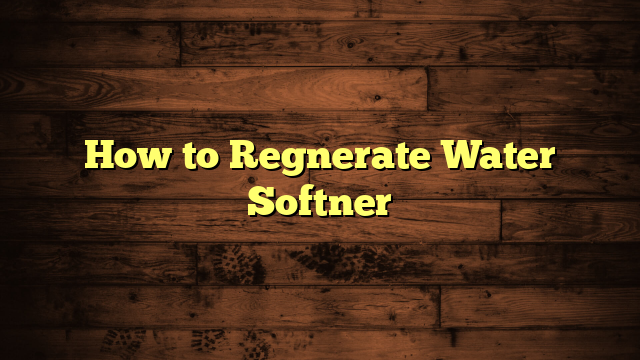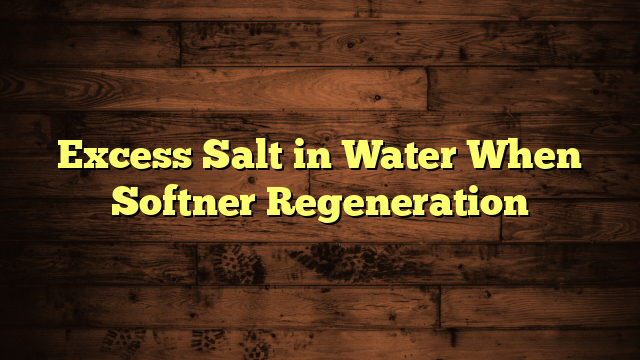How to Regnerate Water Softner
To effectively regenerate your water softener, to maintain its efficiency, and to guarantee peak performance, you need to understand the process involved. Regeneration isn't just a routine task; it's essential for preventing issues like hard water buildup and system failure. You might be wondering about the signs that indicate a need for regeneration or the best methods to initiate the process. By mastering these details, you'll not only enhance your softener's lifespan but also improve your water quality considerably. What's the first step you should take?
Key Takeaways
- Check your water softener's control panel for regeneration options; initiate manual regeneration if needed.
- Ensure the brine tank has adequate salt; refill if levels are low to facilitate the regeneration process.
- Follow the manufacturer's instructions for the regeneration cycle, which usually includes brine tank activation and rinsing.
- Monitor for signs of softener exhaustion, such as scale buildup or poor soap lathering, indicating the need for regeneration.
- Schedule regular maintenance and professional servicing to ensure the water softener operates efficiently and correctly.
Understanding Water Softening
When you understand water softening, you can better appreciate its benefits for your home.
Water hardness is primarily caused by minerals like calcium and magnesium that dissolve in your water supply. These minerals can lead to various issues, such as soap scum, scale buildup in pipes, and reduced efficiency of appliances.
That's where water softening comes in.
The process of water softening utilizes ion exchange, a method that swaps out the hard minerals for sodium ions. When hard water enters the softener, it flows through resin beads coated with sodium.
As the water passes through, calcium and magnesium ions cling to the beads, while sodium ions are released. This exchange effectively reduces the hardness of the water, making it gentler on your skin and your plumbing system.
Signs Your Softener Needs Regeneration
Recognizing the signs that your water softener needs regeneration is essential for maintaining its effectiveness. If you notice any changes in your water quality, it might be time to take action. Pay attention to these indicators, as they can impact softener performance and the regeneration frequency needed.
| Sign | Description |
|---|---|
| Hard Water Symptoms | If you see scale buildup on faucets or dishes, your softener may be exhausted. |
| Soap Ineffectiveness | If soap isn't lathering well, it could indicate that hard minerals are present. |
| Decreased Water Pressure | A noticeable drop in water pressure can signify that your softener isn't working properly. |
| Frequent Regeneration Alerts | If your system frequently indicates it needs regeneration, it's time to check it out. |
Types of Water Softeners
Understanding the different types of water softeners can help you choose the best system for your needs. Here's a brief overview of the main options available:
- Salt-Based Systems: These are the most common. They use sodium ions to replace hard minerals in water, effectively softening it.
- Salt-Free Systems: These systems don't remove minerals but instead alter their structure, preventing buildup in pipes and appliances.
- Dual Tank Systems: If you have high water usage, these are a great choice. They feature two tanks, allowing one to regenerate while the other supplies softened water, ensuring a constant supply.
- Magnetic and Electronic Softeners: These use magnetic or electronic fields to change the properties of hard minerals, making them less likely to stick to surfaces.
Each system has its benefits depending on your household's water needs, budget, and maintenance preferences.
By understanding these types, you can better assess which system will work best for you.
Preparing for Regeneration
Preparing for regeneration of your water softener involves a few simple steps to assure peak performance.
First, check the water quality in your area. This will help you understand how often you need to regenerate your system. If you notice an increase in hardness or experience issues like soap scum, it's time to take action.
Next, confirm you have enough salt for the regeneration process. A well-stocked brine tank is essential for maintaining system efficiency. If you're using potassium chloride instead of sodium chloride, verify that it's suitable for your water softener.
Additionally, inspect the brine tank and control valve for any debris or buildup. Cleaning these components can greatly improve your system's performance and longevity.
Finally, make a note of the regeneration cycle on your calendar. Regularly scheduling this process helps maintain consistent water quality throughout your home.
Manual Regeneration Process
Once you've confirmed your water softener is ready for regeneration, you can initiate the manual regeneration process. This method allows you to take control of the regeneration frequency and guarantee your system is working effectively.
Follow these manual steps to get started:
- Locate the control panel on your water softener unit. This is usually where you'll find the regeneration button.
- Press the manual regeneration button. Depending on your model, it may be labeled differently, so consult your user manual if needed.
- Monitor the process. Regeneration typically takes a couple of hours, so keep an eye on the system to guarantee everything's functioning smoothly.
- Check the salt levels afterward. If necessary, add more salt to the brine tank to prepare for the next cycle.
Automatic Regeneration Process
Now that you understand the manual regeneration process, let's explore the automatic regeneration process.
This system simplifies maintenance by initiating the regeneration cycle based on your water usage, ensuring ideal performance without your constant attention.
You'll also want to familiarize yourself with the control settings, as adjusting them can greatly enhance efficiency and effectiveness.
Regeneration Cycle Overview
The automatic regeneration process is the heart of a water softener's functionality, guaranteeing it continues to provide you with soft water efficiently. This process typically occurs when the system detects that the resin beads are saturated with hard minerals and need recharging.
Here's what you can expect:
- Regeneration Frequency: Your softener calculates how often to regenerate based on your water usage and settings.
- Brine Tank Activation: When regeneration is triggered, your brine tank releases a concentrated salt solution to clean the resin beads.
- Backwashing: The system backflushes the resin tank to remove debris and sediment, preparing it for the brine solution.
- Rinsing: After the brine has cleaned the resin, the system rinses it thoroughly to eliminate excess salt.
This entire cycle can take a few hours, but it's vital for maintaining peak performance.
Understanding this overview helps you better appreciate how your water softener works and guarantees you always have soft water available when you need it.
Control Settings Adjustment
Adjusting the control settings on your water softener is vital for maximizing the automatic regeneration process.
Begin by locating the control panel, usually situated on the top or side of the unit. Here, you'll find settings that allow you to customize the regeneration frequency to suit your household's water usage.
To adjust these settings, first, determine how often your water softener should regenerate. If you have a larger family or use more water, you may need to increase the frequency. Conversely, if your usage is minimal, you can reduce it. Most units offer a manual or automatic option, so choose what works best for you.
Once you've decided, enter the control panel and follow the prompts to adjust the regeneration frequency.
It's important to remember that improper settings can lead to hard water or inefficient salt usage. After making your adjustments, keep an eye on the system for a few weeks to verify it's performing effectively.
If you notice changes in water quality, revisit the control panel and fine-tune your settings as necessary. By taking these steps, you'll help maintain the effectiveness of your water softener and enjoy soft water consistently.
Maintenance Tips for Water Softeners
Regular maintenance is essential for keeping your water softener running efficiently and prolonging its lifespan. By following a consistent maintenance routine, you'll not only enhance performance but also extend the softener's life.
Here are some essential tips to take into account:
- Check Salt Levels: Regularly inspect the salt levels in the brine tank, topping it up as needed to guarantee proper regeneration.
- Clean the Brine Tank: At least once a year, clean the brine tank to prevent the buildup of impurities that can affect performance.
- Inspect for Leaks: Routinely check for leaks or corrosion around the connections and valves. Addressing these issues promptly can prevent bigger problems down the road.
- Schedule Professional Maintenance: Depending on your usage, think about professional servicing every few years. Experts can spot issues you might miss and help maintain peak performance.
Troubleshooting Common Issues
Many homeowners encounter common issues with their water softeners that can disrupt performance and efficiency.
One of the most frequent problems is salt bridging, where a hard crust forms above the salt in the brine tank. If you notice your water feels harder than usual, this might be the culprit. The solution strategy here is to break up the bridge with a broom handle and verify the salt level is adequate.
Another common problem is the resin beads becoming clogged or damaged. If you observe a decrease in water flow or efficiency, consider backwashing the system or replacing the resin entirely.
Lastly, keep an eye on the control valve. If it's malfunctioning, you may experience cycles not completing. In this case, check for clogs or leaks and consult your manual for reprogramming instructions.
Frequently Asked Questions
How Often Should I Regenerate My Water Softener?
You should determine your regeneration frequency based on your water usage. If you use a lot of water, consider regenerating every few days. For lighter usage, once a week might be sufficient to maintain efficiency.
Can I Regenerate My Water Softener During a Water Shortage?
Oh sure, let's waste water during a shortage! Seriously, you shouldn't regenerate your softener then. Prioritize water conservation to maintain softener efficiency. Wait until conditions are better to keep your system running smoothly.
What Happens if I Forget to Regenerate?
If you forget to regenerate, your water softener won't effectively remove hardness. Over time, you'll notice increased water hardness effects, leading to scale buildup and reduced efficiency of appliances, ultimately impacting your water quality.
Is It Safe to Use Softened Water for Plants?
Using softened water on plants is like feeding them candy; it may not be the best choice. Softened water can negatively affect plant growth due to sodium levels, potentially harming your garden's health over time.
Can I Use Table Salt for Regeneration Instead of Salt Pellets?
You can't use table salt for your water softener. It lacks the necessary additives that salt pellets provide, which are essential for effective regeneration. Stick with the recommended salt pellets to guarantee peak performance.
Conclusion
In the journey of maintaining your water softener, think of regeneration as a revitalizing rain after a long drought. By understanding the signs of exhaustion and knowing when to regenerate—whether manually or automatically—you'll keep your system running smoothly. Regular maintenance not only prolongs your softener's life but also guarantees your water remains soft and pleasant. So, stay proactive, and your water softener will reward you with the quality water you deserve.







